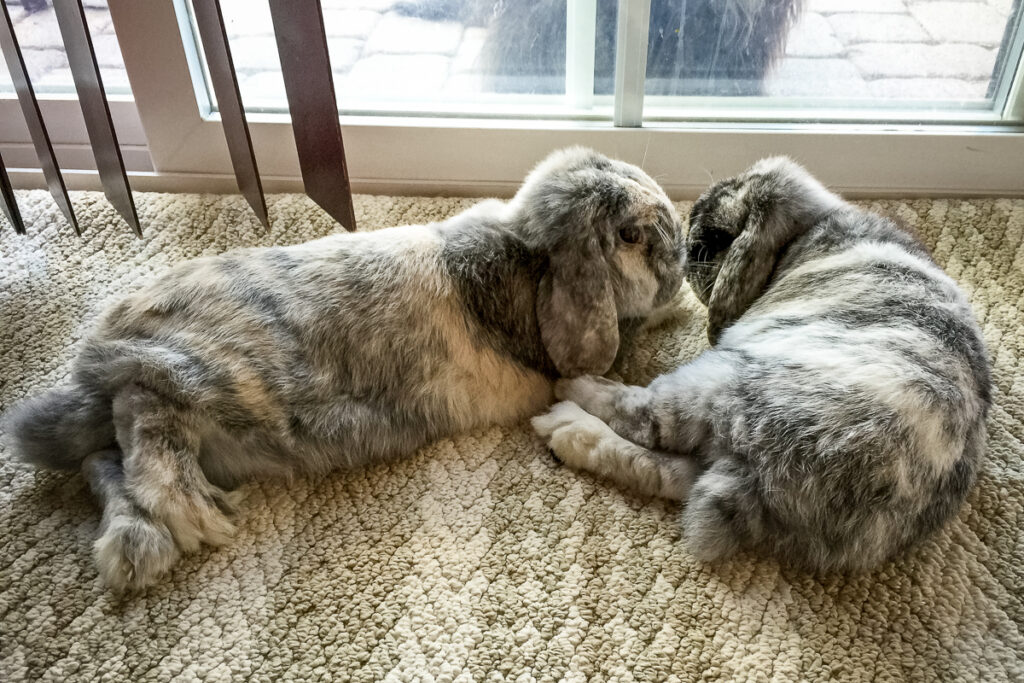Though rabbits are capable of learning certain human words, it’s more important for us to learn their language. By watching our bunnies from a close-up view, we can hear what they have to say when they are “speaking” to humans. In living with different people, rabbits may develop different “dialects,” which are best understood by those who live with them and love them.
Just as in our own language, we have homonyms (the same word with different meanings) so do rabbits. The important thing to bear in mind is context. While a few rabbit “words” are communicated by nasal and vocal sounds, more often they are transmitted by actions or simple postures, which include whole-body smiles.
Basic Vocabulary
Peaceful stretch. Bunny flattens out in a smile on his belly with hind feet extended. When especially happy, toes may curl under or the feet may cross at the ankles.
Sideways flop. If you find your bunny flopped over on his side or back, it doesn’t mean he has had a heart attack. The fluttering eyelids and whiskers indicate that bunny is contentedly in dreamland.
Presentation. Another smile in the horizontal position is assumed by the recipient of petting by a favorite human or grooming by another animal. All feet are tucked under, while the chin is laid out flat on the floor. This is how subordinate rabbits “present” themselves to their superiors. But a presentation is also used as voluntary submission to a loved one, meaning something like: Take me. I’m yours.
Crouching is a tense unrelaxed version of presenting, often with bulging eyes, when the rabbit is not enjoying attention, but rather frozen in fear.
Shuddering. This is a comical whole-body expression. If your hands emit an obnoxious odor—like too much perfume or carburetor cleaner—when you pet your bunny, he may try to shake it off. Sometimes after a rabbit is given medicine, he may shake his coat to rid himself of the bad taste.
Purring. This is a series of fast but light vibrations of the teeth and happily quivering whiskers—activated by gentle stroking behind the ears. It signifies contentment to the Nth degree.
Crunching is a second expression made by the teeth, when bunny is sick or feeling discomfort. Tooth crunching is usually a louder, slower grind, sometimes accompanied by protruding eyes.
Whimpering is a fretting little noise made by a pregnant or pseudo-pregnant female, who is pleading not to be disturbed. Some rabbits whimper when you try to pick them up or move them.
Wheezing sniffs combine vocalizations with nasal sounds to “voice” a protest.
Clucking. A pleasant sound is the faint clucking made by a bunny who has been given a particularly tasty snack. It always means, Yum, yum!
Licking/grooming. This is obvious affection. Rabbits lick each other and sometimes human friends.
Nudging/huddling. More ways to show affection involve sitting close. These friendly gestures are often overlooked by humans. Instead of licking, many house rabbits nuzzle nose-to-nose with their human friends. Nudging your ankle or tugging on your pantleg means, Notice me.
Honking/oinking. Because rabbits draw very little distinction between sexual and social behavior, many expressions are identical. Neutered males and spayed females may still court—circling each other (or your feet). Soft honking or oinking is a love song, also used to solicit food and attention. A honk can mean: I want you, or maybe a treat.
“You might be warned of “danger” that the
furniture has been rearranged.”
Chinning, a benignly assertive gesture, is a peculiar way of claiming property. By rubbing their under-chin scent glands on the items (undetectable to us), they mark them as possessions.
Nipping. This is not necessarily an angry remark. Rabbits are often saying, “Move over.”Sometimes it means, “I’m scared. Put me down!”
Snorting/growling. In anger this may be just a warning or it may coincide with a grunt-lunge-bite directed at an adversary. This kind of anger is predictable and can be prevented.
Erect tail. The excitement shown by a tall erect tail can be caused by the threat of an adversary, the proximity of a potential lover, anticipation of tasty treats, or simply the appearance of a new toy.
Tail twitching. In a competitive or a courting context, rabbits may twitch their tails from side to side and spray their conquests. A modified assertion is simply tail-twitching as a form of “back talk.”
Ear assertions. Ears send and receive messages. Alert forward ears say, I hear you. Alert bi-directional ears say, I hear you and something else, too. Menacing, tightly pulled back ears say, Watch out!
Kicking. In protest, kicking is high and to the back. In play or combat, rabbits kick to the side.
Dancing. You’ll know it when you see this frolicking series of sideways kicks and mid-air leaps accompanied by a few head shakes and body gyrations. Many rabbits have literally danced their way into human hearts.
Thumping. This has several meanings: I detect something out of the ordinary, or I have an announcement to make. Rabbits thump over many things—sights, sounds, smells, and things that we don’t sense. It might be a danger signal, and then again it might not be. You might be warned of “danger” that the furniture has been rearranged. Yet, this sense of propriety is the very thing that can make a rabbit a highly suitable individual to share your home.
©Copyright Marinell Harriman. All Rights Reserved. Republished with the permission of the author.
Rabbitspeake was originally published in House Rabbit Handbook (5th ed.).

